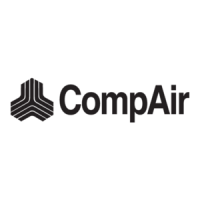87
* If the engine was started cold, let it
warm up for approximately 2 minutes
and then press the START/RUN valve
(2). If the engine is warm, the START/
RUN valve can be pressed immediately.
* The installation is now ready to operate.
Check that all the hoses and tools have
been connected correctly and open the
desired air outlet valves.
Start-up using jumper cables / auxiliary
batteries
Fig. 20
Danger
Longer operation with an auxiliary
battery or jumper cables connected can
lead to sudden emissions of gas. An
inflammable air / gas mixture is formed.
Explosion hazard!
Attention
Serious damage can be caused to the
electrical system if wrongly connected.
* Ignition switch in position
(Off-Aus)
* First connect positive terminal then
negative terminal (ground).
* Start as described in section “Starting up
the compressor.”
Note
After the engine has started, first
disconnect the negative cable (ground)
and then the positive cable.
Cold-starting diesel engines with ether
fuel systems
Attention
For cold starts (winter operation) Start-
pilot or any other starting aid may be
sprayed directly into the engine air filter
(Attention: do not confuse this with the
air filter for the screw compressor). (It is
essential that the engine operating
manual be observed.)
Never use the ether cold-starting aid
while the engine is running, as this can
lead to serious damage.
Before using the ether cold-starting aid,
carefully read the instructions and the label
on the tank.
Danger
Never store the ether tank at tempera-
tures above 70
°
C.
Note
Follow the instructions for operating the
compressor at an ambient temperature of
less than 0
°
C, in Chapter 5, Transport and
Installation on Site, in this operating
manual.
7.4 Setting the operating pressure
Fig. 21
Danger
The setting of the operating pressure
may only be carried out by a specialist.
The operating overpressure of the screw
compressor is set by the manufacturer
(see the identification plate on each
compressor).
Pressure values between 5 or 8 bar and
the operating overpressure can be set in
accordance with the identification plate on
each compressor. Pressure values higher
than this are not permitted.
Operating pressure is set by a specialist
at the controller.
* Remove counternut below the control
knob of the regulator.
* Raise pressure by turning the adjusting
knob of the regulator clockwise
(towards +).
* Lower the pressure by turning the
adjusting knob of the regulator
anticlockwise (towards -).
* In order to lower the pressure, open an
air discharge valve.
* After altering the pressure, lock the
adjusting knob using the knurled nut.
This readjusted operating pressure is to
be checked using the pressure gauge on
the instrument panel at 100% air discharge
and maximum engine speed.
7.5 Monitoring / fault
Danger
Bridging the safety switch in the
automatic monitoring system is not
permitted!
The display on the pressure gauge may
not go further than the red line.
When the “Fault” indicator lamp lights up,
the screw compressor is automatically shut
down when the following faults occur:
* Fuel shortage
* Compressor temperature too high
* Engine oil pressure too low
* Engine oil temperature too high
After one of these faults, it is only
possible to restart the machine after the
fault that caused the machine to be shut
down has been corrected.
Attention
Disconnect the battery or generator only
when the engine is not running.
* Switch off the machine if the
compressed air transports oil spray or if
excessive oil is consumed. (Refer to the
trouble-shooting section)
* Check that the "battery charge" pilot
lamp is not illuminated. If it glows, even
weakly, refer to the trouble-shooting
section.
* Check that the air pressure (7) assumes
a value within the permissible pressure
range.
If the machine cuts out, before switching
off at the ignition switch (1) carry out the
following checks:
* Interrupt the electric connection to the
engine oil pressure switch immediately
after the engine has cut out and leave it
in the interrupted state.
If the "fault" pilot lamp goes out
immediately this indicates that either a
too low engine oil pressure or a lack of
fuel or a defective engine has led to the
cut-out.
* If the light continues glowing this
indicates that an excessive engine
temperature or compressor temperature
led to the cut-out.
7. Putting the compressor into operation

